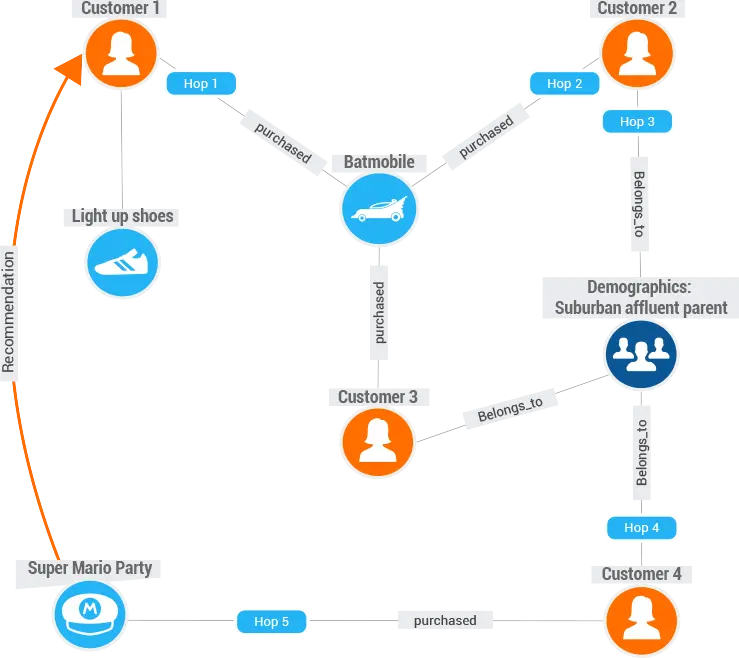Graph Database Recommendation Engine
Deliver Personalized Recommendations With TigerGraph

Personalized Recommendations Can Significantly Increase Revenues
Every business faces the challenge of maximizing the revenue opportunity from every customer interaction. Companies offering a wide range of products or services face the additional challenge of matching the right product or service based on immediate browsing and search activity along with the historical data for the customer. Recommendation systems are designed to tackle this business need and the impact can be huge: Amazon, with its unmatched catalog size, reports that 35% of its sales comes from cross-sell and up-sell recommendations.
Additionally, the more personalized the recommendation, the greater the return. 82% of consumers report being influenced by a personalized shopping experience. Purchases with recommendation clicks result in a 10% higher average order value and the per-visit spend of a shopper who clicks a recommendation is five times higher.


Legacy Recommendation Systems Are Insufficient for Increasing Revenues
Early recommendation engines, although breakthroughs at the time, simply looked at a couple of connected data points when making recommendations. These recommendation systems perform global statistical computations offline, using snapshots of data that can be days old. They lack the real-time modeling and nuanced profiling needed today.
Real-time speed is essential. Website visitors have short attention spans: catch them now, or they’re gone. For retailers, their product catalogs can change by the minute. Recommenders need to quickly understand their client’s profile, align that with the rapidly changing profiles of the larger customer base and product catalog, and produce engaging, personalized recommendations.
Why TigerGraph, a Native Parallel Graph Database, To Build a Real-time Deep Link Recommendation Engine?
Graph Databases Enable Personalized Recommendations
Using graph analytics for recommendations is the first step towards faster and more personalized recommendations. It’s worth remembering that the standard collaborative filtering algorithm is a 3-hop graph query:
(People → who bought the product ← which you just bought) → also bought these other products.
But all graph databases are not created equal. TigerGraph easily handles multiple hops, while many others struggle with more than two hops. TigerGraph’s deep link analysis lets vendors customize and extend their analytics, enabling more hops to collect product features, customer demographics, and the context of the current situation, resulting in more accurate and more personalized recommendations.


Graph Databases Enable Real-Time Recommendations
TigerGraph not only delivers personalized results, but it also does it in real-time. The result is the capture of key Business Moments, transient opportunities where people, businesses, data, and things work together dynamically to create value. TigerGraph lets businesses capture these moments to personalize the customer experience, leading to more transactions.
One eCommerce leader uses TigerGraph to help drive online, personalized recommendations for its 300 million users. It uses TigerGraph to model its catalog of millions of products from thousands of vendors, and its consumer data, including each shopper’s real-time behavior on its website. The result is a better shopping experience with offers that are more likely to result in an initial sale, up-sells, and cross-sells.
Machine Learning Improves the Effectiveness of Personalized Recommendations
Graphs with real-time deep link analytics are also powering the next generation of AI-based recommenders and using machine learning to understand user behavior and preferred actions better than before. Have you ever made a major online purchase, such as a TV or washing machine, and then the recommender asks if you would like to buy a similar product? No. An intelligent recommender would recommend accessories instead.
Similarly, an informed recommender can use the shopper’s browsing behavior to guess at what stage a shopper is at: looking around, evaluating multiple options, price shopping, vacillating, etc. Then the recommender can make an appropriate suggestion to nudge the buyer along.


